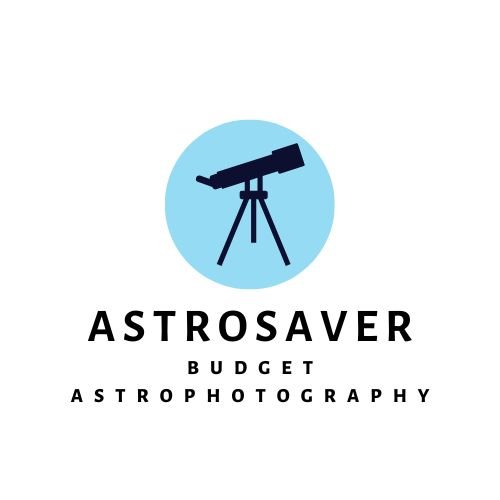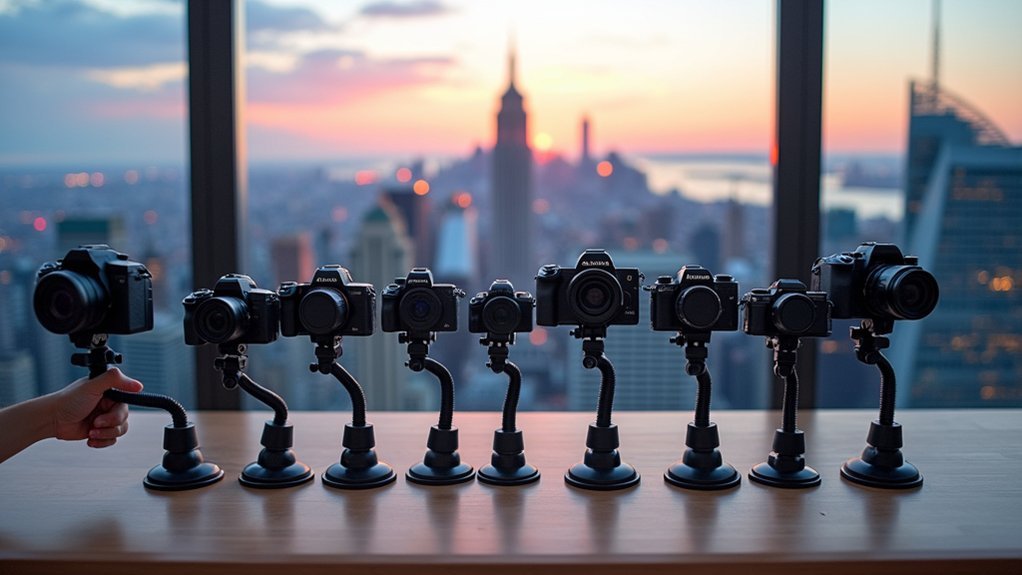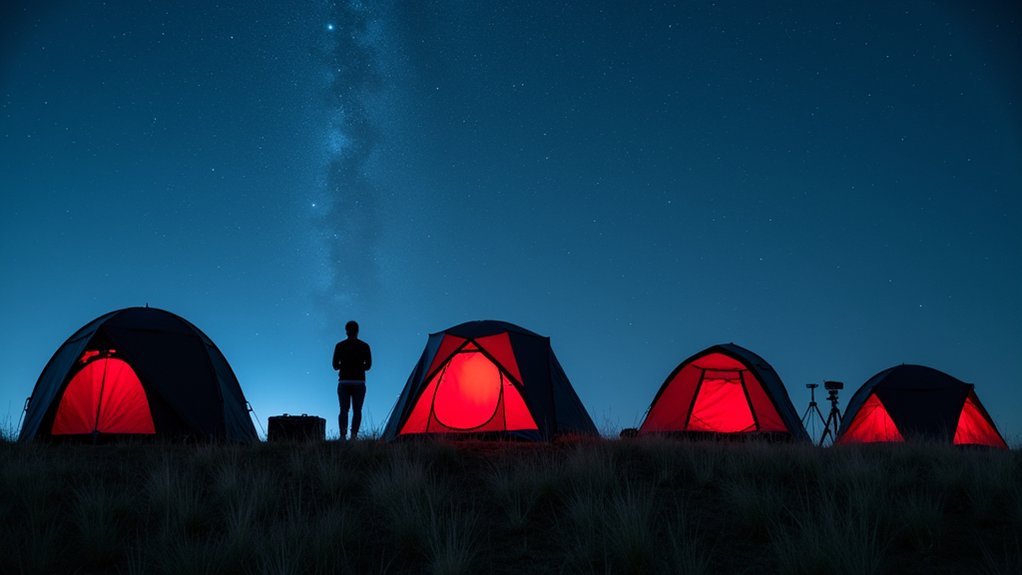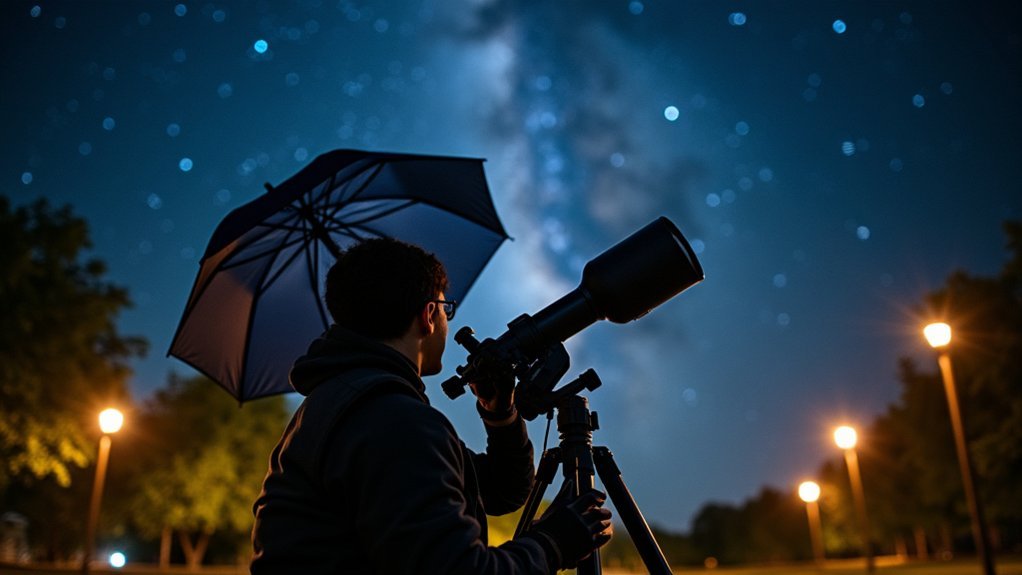Manual star tracking lets you capture deep sky photos without expensive motorized mounts. You’ll need a stable tripod, a barn-door tracker (two hinged boards with a threaded bolt), and patience for making continuous adjustments. Align your setup with the North Star, take multiple short exposures (30-60 seconds), and stack them with software like Deep Sky Stacker. Regular practice improves your timing and precision. The night sky reveals its secrets to those who master these fundamental techniques.
The Fundamentals of Manual Star Tracking
Two critical components form the foundation of manual star tracking: technical skill and mechanical precision.
When photographing deep sky objects, you’ll need to compensate for Earth’s rotation by continuously adjusting your telescope’s position using RA and Dec knobs. This precision work keeps celestial targets centered in your frame throughout the exposure time.
A barn-door mount aligned with the North Star or Southern Celestial Pole simplifies this process considerably. With proper alignment, you’ll only need to turn the tracking bolt once per minute to match stellar movement.
Your equipment matters too—a stable tripod prevents unwanted vibrations that can blur images.
While manual tracking requires practice, mastering this skill deepens your understanding of celestial mechanics and builds a strong foundation for your astrophotography journey, even if you later upgrade to motorized systems.
Building a Simple Barn-Door Tracker
You’ll need essential components like hinges, carriage bolts, and a camera mount to construct an effective barn-door tracker for astrophotography.
The assembly process involves connecting wooden boards with hinges and installing a precisely threaded bolt that you’ll turn at one revolution per minute to match Earth’s rotation.
Proper calibration requires aligning the hinge axis with the celestial pole and adjusting your tripod to match your latitude for accurate star tracking.
Essential Components Needed
The foundation of any DIY barn-door tracker lies in its basic structural elements. You’ll need two wooden boards connected by hinges that allow for the precise rotation needed to counter Earth’s movement during astrophotography sessions.
Your supply list should include four hinges total, four 1/4-20 carriage bolts (about 4.5 inches long), and two 1/4-20 T-nuts to secure everything firmly.
Don’t forget a camera ball mount for the top board—this critical component lets you position your camera exactly where you need it while the tracking mount does its work.
For smoother operation, sand down any text on the bolt heads and add a Teflon piece to minimize wobble.
Proper alignment with celestial poles guarantees your homemade tracking mount delivers one minute of compensation per turn.
Assembly Step-by-Step
Following these five steps will transform your materials into a functional star tracker. Start by cutting two triangular wooden boards and securing them with four hinges to create a stable foundation. Sand the carriage bolt’s head for smooth movement, then attach it through a T-nut embedded in the structure.
Mount the camera ball on the top board, allowing flexible positioning for different astrophotography compositions. Set your tripod angle to match your latitude for proper star alignment.
| Component | Function | Installation Tip |
|---|---|---|
| Wooden Boards | Foundation | Cut precisely for stability |
| Hinges | Pivot point | Secure with all screws |
| Carriage Bolt | Tracking axis | Sand head for smoothness |
| T-nut | Bolt anchor | Press firmly into wood |
| Camera Ball | Mount point | Tighten fully before exposures |
Use a red-display stopwatch app to time your manual adjustments during long exposures.
Calibration and Alignment
With your barn-door tracker assembled, proper calibration becomes the next challenge for capturing crystal-clear star images. Achieving accurate polar alignment is vital—you’ll need to position your tracker so its hinge axis points directly at the North Star (or Southern Celestial Pole for southern hemisphere observers). This alignment must match your specific latitude for effective tracking.
- Secure your tracker to a heavy-duty tripod and adjust the mount’s angle to match your latitude, ensuring the hinge axis aligns properly with the celestial pole.
- Install the Teflon piece between the bolt assembly components to minimize wobble and enhance tracking precision.
- Test your calibration by turning the bolt at one revolution per minute while monitoring star movement through your camera.
Remember to check your alignment periodically throughout your imaging session, especially as temperature changes can affect tracking accuracy.
Essential Equipment for Non-Motorized Imaging
Success in manual star tracking depends heavily on having the right gear before you point your camera skyward. A sturdy tripod serves as your foundation, eliminating vibrations that would otherwise ruin long exposures.
You’ll need a star tracker like a barn-door mount to compensate for Earth’s rotation, allowing exposures beyond 30 seconds without star trails—essential for capturing deep sky objects.
Don’t overlook a quality camera ball mount for secure attachment to your tracking setup. When shooting, work with 30-60 second exposures and stack multiple images for better results.
For precise focusing, which is critical in astrophotography, consider using a bahtinov mask. This simple tool will help you achieve perfect focus on stars even in challenging low-light conditions.
Setting Up Your Manual Tracking System
Building your barn-door mount requires precise hinge alignment with the celestial pole and a threaded bolt system that turns once per minute to counter Earth’s rotation.
You’ll need to secure your setup to a stable tripod or wooden base that can support your camera’s weight without shifting during long exposures.
Connect your camera using a T-nut system that allows for proper positioning and swiveling while maintaining the tracking accuracy essential for capturing clear star images.
Barn-Door Mount Assembly
Assembling your barn-door mount requires attention to several key components that work together to track the night sky. This simple yet effective design consists of two wooden pieces joined by a hinge, with a threaded bolt that allows precise movement to compensate for Earth’s rotation during longer exposure lengths.
For proper alignment, verify you:
- Sand the bolt head smooth and install a T-nut inside the mount to reduce wobble and verify fluid tracking.
- Mount the structure on a heavy-duty tripod, setting the angle to match your latitude for proper alignment with the celestial pole.
- Consider adding a laser mount to improve alignment accuracy for tracking stars during extended exposures.
The carriage bolt attachment to your tripod head will provide the stability needed for precise positioning during your astrophotography sessions.
Tripod Stability Solutions
Three critical factors determine whether your manual star tracking system will capture clear, sharp images or produce frustrating star trails and blurs. First among these is tripod stability. You’ll need a sturdy foundation that eliminates vibrations during long exposures.
| Stability Solution | Benefits | Best For | Implementation |
|---|---|---|---|
| Heavy Tripod | Minimal vibration | Windy conditions | Use locking mechanisms |
| Latitude-Aligned Mount | Proper celestial tracking | Manual tracking | Set angle equal to your latitude |
| Adjustable Tripod Mount | Portability with stability | Travel astrophotography | Install quick-release plates |
| DIY Wooden Platform | Maximum stability | Budget setups | Construct using 2x4s with hinges |
For ideal results, mount your camera using a carriage bolt for precise positioning adjustments. This setup allows you to track stars manually while maintaining the stability required for sharp, detailed astrophotography.
Camera Connection Options
Securing your camera properly to your tracking system stands as the foundation of successful manual star tracking.
Your choice of camera connection will greatly impact stability during longer exposures, ultimately determining the quality of your deep sky photos.
- Direct mounting – Attach your camera using mounting rings with 1/4-20 threaded holes directly to your tracking mount for maximum stability during extended exposures.
- Ball head configuration – Install a high-quality ball head between your camera and telescope to achieve precise alignment adjustments while maintaining solid connection.
- Piggyback setup – Mount your camera with its own lens onto the telescope to leverage the tracking capabilities while capturing wider field views.
Select your connection method based on your camera’s weight and the specific celestial objects you’re targeting.
Selecting Suitable Celestial Targets

When attempting manual star tracking, your choice of celestial targets can make the difference between frustration and success. For deep sky astro without tracking equipment, prioritize bright, large objects that reveal detail even with short exposures.
The Orion Nebula stands out as a prime candidate, offering impressive brightness and structure even with limited exposure time.
Andromeda Galaxy (M31) delivers excellent results when you stack over 100 subs, effectively enhancing detail while minimizing noise.
Consider large globular clusters like Omega Centauri as well, though you’ll need numerous brief exposures to prevent star trailing.
The Triangulum Galaxy presents more challenges than Andromeda, requiring careful exposure planning.
For consistent success with manual tracking, you’ll achieve your best results focusing on larger, brighter celestial objects.
Exposure Techniques for Static Mounts
Despite lacking motorized tracking capabilities, static mounts can still yield impressive deep sky images if you master the appropriate exposure techniques. When using a static mount, always follow the 600 rule—divide 600 by your lens focal length to determine maximum exposure time in seconds before stars begin to trail.
- Capture multiple short exposures (30-60 seconds) rather than one long shot—these can be stacked later to enhance details while reducing noise.
- Set your camera to RAW format with ISO between 800-1600 to balance sensitivity against noise levels while capturing faint deep sky objects.
- Use an intervalometer or remote shutter release to minimize vibrations that could blur your images.
Remember to check focus and alignment regularly, as static mounts require vigilant monitoring to keep celestial targets properly framed throughout your imaging session.
Image Stacking to Overcome Tracking Limitations
When working with a static mount, you’ll need to take multiple short exposures of 30-60 seconds to prevent star trailing while still capturing enough light.
Software like Deep Sky Stacker can align and combine these short exposures, dramatically improving your signal-to-noise ratio and revealing details invisible in single frames.
For best results, aim to collect at least 50 sub-frames totaling 2-3 hours of integration time, and don’t forget to capture calibration frames to correct for optical imperfections.
Brief Exposure Fundamentals
Although manual star tracking presents inherent limitations for long exposures, image stacking offers a powerful solution to capture detailed deep sky objects without expensive motorized equipment. By combining multiple short exposures of 30-60 seconds each, you’ll dramatically reduce noise while preserving precious detail.
For ideal results with manual tracking:
- Capture at least 50 subs for decent detail, pushing beyond 100 to reduce noise by a factor of 10.
- Apply the 600 rule (divide 600 by your lens focal length) to determine maximum exposure time before star trailing occurs.
- Always shoot in RAW format and collect calibration frames (flats, darks, bias) during your session to maximize stacking benefits.
Remember that successful stacking depends on quality source material—even brief exposures can yield impressive results when properly planned and executed.
Software Alignment Techniques
Most amateur astrophotographers can overcome manual tracking limitations through powerful software alignment techniques. Programs like Deep Sky Stacker transform multiple short exposures into stunning composites that reveal faint details while reducing noise.
Before stacking, convert your images to TIFF format to preserve quality and guarantee compatibility. Collect several hours of data, even with brief exposures, to achieve impressive results when combined.
The stacking process benefits greatly from calibration frames—flats, darks, and bias frames—which correct vignetting and sensor noise.
Utilize specialized software features like Intersection Mode and Align RGB Channels to optimize your stacks. These tools guarantee proper alignment of your images, maximizing detail retention in your final photograph despite tracking constraints.
With these techniques, you’ll achieve remarkable image quality even with manual tracking.
Mastering Manual Adjustments With RA and Dec Knobs
The humble RA and Dec knobs represent the direct connection between you and the cosmic dance above. Your manual adjustments to the Right Ascension knob need consistent timing—ideally every 30 seconds—to counteract Earth’s rotation.
To achieve proper tracking accuracy, verify your mount is level and properly polar-aligned before beginning your observation session.
- Practice your timing by setting a discreet timer or counting in your head while maintaining focus on your target.
- Start with brighter objects to develop your technique before attempting dimmer deep sky objects.
- Use short exposures initially, gradually increasing duration as your confidence and skill improve.
With practice, you’ll develop an intuitive feel for how celestial objects move across your field of view, making manual tracking second nature.
Practical Field Tips for Stable Images
Achieving crisp, stable images during manual star tracking requires both technical precision and practical field strategies. Start by securing your camera on a solid tripod and aligning it to your latitude for proper celestial tracking.
Apply the 600 rule to determine ideal exposure times—divide 600 by your focal length to prevent star trails. Instead of one long exposure, capture multiple short exposures (30-60 seconds) for later stacking, which dramatically improves image quality while minimizing light pollution effects.
Monitor focus consistently, especially as temperatures drop throughout your session, as even slight focus shifts can ruin detailed shots. Use a stopwatch app to time your manual adjustments, ensuring you compensate for star movement at regular intervals for those stable images that showcase deep sky objects in their full glory.
Star Trail Prevention Without Motors
While dedicated star trackers and motorized mounts offer convenience, preventing star trails without motorized equipment remains both possible and rewarding for astrophotographers on a budget. The secret lies in understanding exposure fundamentals and manual tracking techniques.
- Apply the 600 rule – Keep your exposures under 600 divided by your focal length in seconds to minimize star elongation (e.g., 30 seconds for a 20mm lens).
- Stack multiple short exposures – Instead of one long exposure, take hundreds of shorter ones (30-60 seconds) and combine them to reduce noise while avoiding trails.
- Make consistent adjustments – Regularly fine-tune your RA and Dec during shooting sessions to keep celestial objects centered in frame.
Your manual tracking setup, whether a simple barn-door mount or a telescope with camera attachment, can yield impressive deep sky images with these principles applied consistently.
Tripod Modifications for Enhanced Stability
Since your tracking efforts will fail without a rock-solid foundation, proper tripod modifications represent the cornerstone of successful manual star tracking.
Begin by constructing a heavy-duty tripod using 2x4s for superior stability compared to standard commercial options. Set your tripod angle equal to your latitude for proper alignment during long exposures.
Install adjustable hinges to increase flexibility while framing celestial targets. A carriage bolt on the tripod head enables precise camera positioning, critical for accurate manual tracking.
Confirm your setup has a solid, vibration-free base by checking for wobble before each session.
A properly balanced tripod not only improves image quality but also reduces motor stress and extends battery life.
These modifications will transform your manual tracking capabilities, allowing for sharper deep-sky photos without expensive motorized equipment.
Calculating Maximum Exposure Times
Three critical calculations determine your success in astrophotography when manually tracking stars. Without motorized mounts, you’ll need to carefully determine how long your shutter can stay open before stars streak across your frame.
- Apply the 600 rule by dividing 600 by your lens’s focal length—a 50mm lens yields a maximum exposure time of 12 seconds before star trails appear.
- Consider your DSLR or mirrorless camera’s sensor pixel size using the NPF formula for more precise calculations that account for your specific equipment.
- Opt for multiple shorter exposures instead of one lengthy shot, as this improves your Signal to Noise Ratio while minimizing the risk of star elongation.
Through experimentation, you’ll find the sweet spot that balances light gathering with star sharpness for your particular setup.
Overcoming Common Manual Tracking Challenges
Despite your best preparations, manual tracking presents several frustrating challenges that can compromise your astrophotography results. When pursuing deep sky objects without motorized assistance, you’ll need to develop specific techniques to maintain alignment during exposure.
| Challenge | Solution |
|---|---|
| Star trailing | Keep exposures shorter than 600÷focal length |
| Hand fatigue | Use a comfortable stool at proper height |
| Losing target | Start with bright objects like Orion Nebula |
| Inconsistent adjustments | Mark initial position on RA/Dec knobs |
Your tripod setup is essential—ensure it’s stable yet allows smooth manual adjustment without introducing vibrations. Remember that larger, brighter deep sky targets are more forgiving of tracking errors while you build your skills. With practice, you’ll develop a rhythm to your manual tracking, allowing slightly longer exposures without star trails.
Frequently Asked Questions
Can You Do Astrophotography Without a Tracking Mount?
Yes, you can do astrophotography without a tracking mount. You’ll need to take many short exposures of larger, brighter objects and stack them later to reduce noise and maintain sharp star shapes.
How to Use a Star Tracker for Astrophotography?
To use a star tracker, align it with Polaris/SCP, balance your equipment, mount your camera, and set exposure times of 30-60 seconds. Take multiple shots while periodically checking focus throughout your imaging session.
How to Do Untracked Astrophotography?
For untracked astrophotography, you’ll need to take many short exposures (50-100+) following the 600 rule, use a sturdy tripod, and stack your images later. Focus on larger, brighter objects for best results.
How Do You Track Star Movement?
You track star movement by continuously adjusting RA and Dec knobs on your mount or using a barn-door tracker aligned with Polaris. You’ll need to make precise corrections to counteract Earth’s rotation during imaging sessions.
In Summary
You don’t need expensive equipment to capture stunning deep sky images. With your DIY barn-door tracker, careful setup, and proper technique, you’ll be taking impressive photos in no time. Remember to practice your manual tracking skills, choose appropriate targets, and work within exposure limitations. The satisfaction of capturing celestial wonders with your own hands makes the extra effort worthwhile. Keep looking up!




Leave a Reply